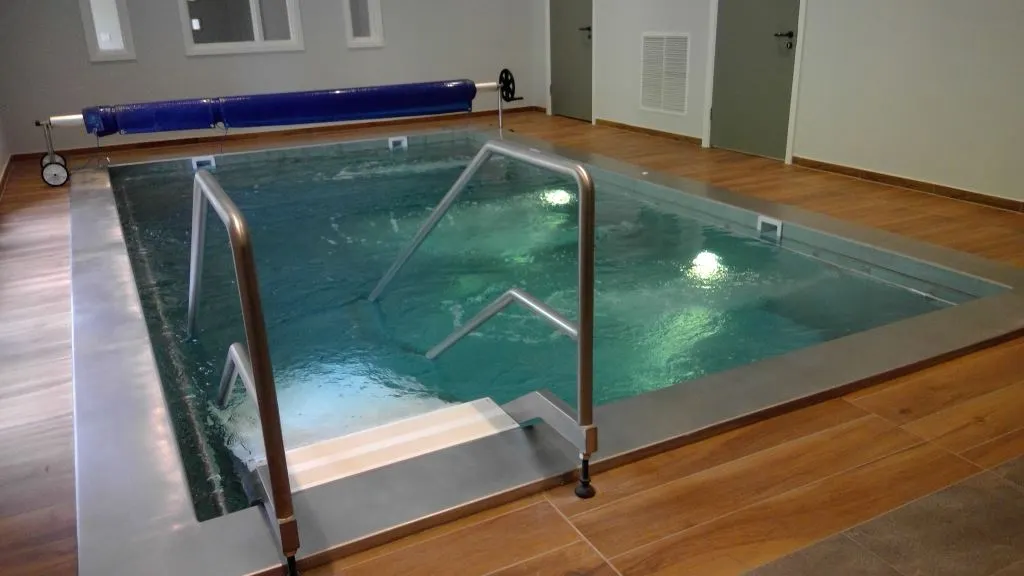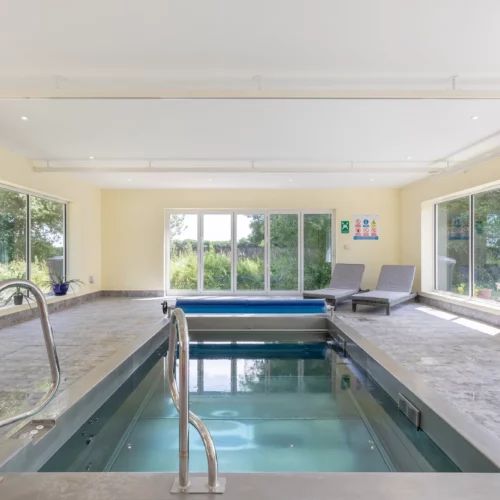Concrete Pool Aesthetics
Traditionally, concrete with ceramic tiling has been the preferred choice for hydrotherapy pool construction, especially in terms of aesthetics.
Hotels and resorts build tiled swimming pools to create a sense of elegance, and as a result, many owners of healthcare settings wanted to replicate that with their hydrotherapy pools.
Tiling has long been considered a premium finish for pools, especially along the waterline.
For instance, using blue and white colour patterns can make the water appear bluer, whilst also avoiding the washed out look that rendered finishes often have over the waterline.
Bespoke Abilities With a Stainless Steel Hydro Pool
Concrete may be the traditional choice, but with stainless steel, you have a material that enables you to design a hydrotherapy pool that is bespoke for your care needs.
Combining durability with contemporary design, stainless steel is a sleek, reflective surface, making it perfect for promoting relaxation and calmness — exactly what you need for your physiotherapy sessions!
A one-piece hydrotherapy pool is made from a single piece of stainless steel, creating a made-to-measure option to best suit you and your client’s needs. This versatility makes it perfect for any healthcare environment, as the design can be customised to be fitted with additional features like water jets, coloured lights, wave systems, and waterfalls.
By adding stainless steel handrails and fixings to compliment the structure, it is clear to us that stainless steel gives you a much smarter finish than a traditional tiled pool.
Steps Rehabilitation Centre Hydrotherapy Pool Installation
If you haven’t seen a stainless steel hydrotherapy pool before, check out the video below of the one we installed for STEPS Rehabilitation Centre in Sheffield!
Stainless Steel Pool Durability
In most environments, it is fair to say that concrete is very durable.
Many people use it for swimming pools, as sharp objects are unable to damage the pool structure because of its rough surface.
However, it is a different case with hydrotherapy pools.
A normal swimming pool is usually no hotter than 28°C, but with a hydrotherapy pool, the water temperature is typically about 33 — 36°C.
Concrete is heavy and tends to settle, shift and crack over time. With higher water temperatures, it makes rooms more humid and accelerates this process.
As the tiles crack and pop out of place, you’ll need to resurface the pool on average every 10-15 years — an expensive and time-consuming process! This is often unaccounted for in terms of additional maintenance downtime and expense that is not factored into the initial install cost.
To learn more about how hydrotherapy works, take a look at the following blog:
Designed To Last a Lifetime
While concrete struggles to deal with the higher temperatures of a hydrotherapy pool, stainless steel is renowned for being one of the toughest and most durable produced materials on the planet.
Its forgiving properties allow for more flexibility when surrounding conditions fluctuate and change, whilst its combination of malleability and strength makes it suitable for almost any environment.
When properly maintained, it will not crack, peel, erode, or fade.
What maintenance does a hydrotherapy pool require?
One of the most important elements of assessing a hydrotherapy pool’s durability is how water-tight it is. With a stainless steel pool, it is cast and installed in one-piece, so there are no edges or corners that are vulnerable to deterioration and subsequent leaks.
It is completely sealed, so water loss is limited to evaporation.
In addition, the rigidity of stainless steel makes it a lot more long-lasting and corrosion-resistant than concrete, ensuring it is cheap to look after, and ultimately, saving you time and money.
Hydrotherapy Pool Servicing
Easy to service and maintain, our servicing department offer packages on all of our stainless steel hydrotherapy pools.
Stainless Steel Pool Cost and Installation
Hydrotherapy pools can start at anywhere from £70,000 and go all the way up to £200,000+ depending on the size. Costs can also vary depending on factors including plant rooms, environmental controls, and other factors.
How much does a hydrotherapy pool cost?
Material also plays an important role on cost with installation and maintenance.
Time is money and when looking at installation times between concrete and stainless steel, there is a big difference.
Complex Installation
Concrete pools with ceramic tiles require a complex and lengthy installation period, with the first stage involving excavators digging a hole for your pool, before work on drainage layers, framework and plumbing are completed.
Once that is finished, the concrete is then sprayed, requiring three or four weeks for curing before the final works can take place. Tiling, coping, and other finishing details on average take another four to six weeks to complete.
As you can see, once you have factored in all of these processes, a concrete pool can take four to six months to install.
Are Stainless Steel Pools Cost Effective
Installing a hydrotherapy pool with concrete and ceramic tiles is a time-consuming and potentially costly process.
They are reliant on other external factors, such as the weather, in determining whether installations go ahead on time, and those delays can add to your total costs.
However with a stainless steel hydrotherapy pool, those issues are not a problem.
Cast in one complete mould, stainless steel hydrotherapy pools can be craned in with ease and don’t require complex assembly when on-site. By making the installation of your hydrotherapy pool a much quicker and simple process, it offers you a far more cost-effective option.
What is the Hydrotherapy Pool installation process?
That’s why Kingfisher School opted for stainless steel for their hydrotherapy pool. Check out their video below!
Maintenance
Thanks to the enduring nature of stainless steel, little maintenance is necessary to keep a stainless steel pool looking great. Regular flushing of exposed areas with clean water and wipe down with a clean cloth will keep the finish pristine.
In contrast, concrete pools require much more maintenance, making them more expensive to run longer term.
For instance, in a concrete pool, the water will leach calcium out of the surface of the pool if there is not enough calcium in the water–which causes further pitting and roughness.
Not only does this mean that the calcium levels in the water needs to be frequently monitored, it will also cause the pool to fade, peel and crack.
Stainless Steel Pool Infection Prevention
Have you ever gone to a swimming pool and noticed how discoloured, and sometimes mouldy, the grouting between the tiles are?
It is an issue that also applies to concrete hydrotherapy pools, as the grouting between ceramic tiles are particularly susceptible to bacteria growth.
Cracked tiles and grout all provide a comfortable, warm, moist surface where mould and bacteria can grow, causing a detrimental impact on maintaining good levels of infection prevention.
With that in mind, it is clear to see why so many hospitals, SEN Schools and rehabilitation centres are moving to stainless steel.
Stainless Steel Pools Ensure Effective Infection Prevention
Infection prevention is a priority in every care setting, so a hydrotherapy pool that is easy to clean is a necessity.
Stainless steel has a smooth, completely intact surface, eliminating any potential nooks or crannies where bacteria can harbour. Not only is it quick and easy to clean, it is also much tougher and more difficult to scratch and damage than concrete.
This is precisely why it’s used in surgical equipment due to its efficacy for infection prevention.
Whereas concrete hydrotherapy pools are tough to clean due to grouting and cracked ceramic tiles, stainless steel provides an option that is simple and effective.
You can learn more about effective infection prevention in healthcare equipment in this article:
Summary
Whilst concrete models with ceramic tiles look the most traditional, they’re not the most cost-effective or easiest solution to go with.
That’s why we use stainless steel for our hydrotherapy pools!
Concrete is tough to clean, making it a difficult to maintain high standards of infection prevention in your care environment. Stainless steel is not just quick and easy to clean, it is requires less maintenance and is far more durable.
Whether it is from a health perspective or cost, the benefits of stainless steel make it a clear winner in our eyes.
Get in touch with our friendly team to find out more about our range of hydrotherapy pools!



